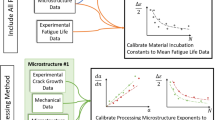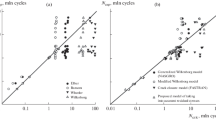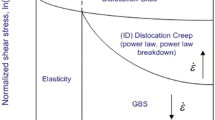Abstract
A new method is described for calculating the long fatigue life (>105 cycles) portion of the stress-life (S-N) fatigue curve for precipitation-hardened aluminum alloys. It is based upon a finite element model of the deformation of a persistent slipband (PSB), and the only material parameter required is the ultimate tensile strength (UTS) of the alloy. The stress dependence of the plastic strain at the tip of a PSB is shown to be very pronounced and to closely match that of anS-N fatigue curve. Very good agreement is obtained for 6061-T6, 2014-T6, 2024-T4, and 7075-T6 aluminum, and the fatigue strength (at 108 cycles) is calculated to be 26 pct of the tensile strength of each alloy, in agreement with experimental data. By contrast, the plastic strain at a crack tip has a much weaker stress dependence. Thus, these calculations also confirm that the elongation of a PSB, and not crack growth, is the rate-controlling process in high cycle fatigue.
Similar content being viewed by others
References
N.E. Frost, K.J. Marsh, and L.P. Pook:Metal Fatigue, Clarendon Press, Oxford, 1974, p. 46.
O.H. Basquin:Proc. ASTM, 1910, vol. 10, pp. 625–30.
L.F. Coffin:Trans. ASME, 1954, vol. 76, pp. 931–50.
S.S. Manson:NACA Tech. Note, 1954, no. 2933.
B. Meier and V. Gerold:3rd Int. Conf. on Fatigue and Fatigue Thresholds, Charlottesville, VA, R.O. Ritchie and E.A. Starke, Jr., eds., Engineering Materials and Advisory Services Ltd., Cradley Heath, Warley, West Midlands, U.K., 1987, pp. 323–32.
A.F. Blom, A. Hedlund, W. Zhao, A. Fathulla, B. Weiss, and R. Stickler:Behavior of Short Fatigue Cracks, K.J. Miller and E.R. de los Rios, eds., Mechanical Engineering Publications Ltd., London, 1986, pp. 37–66.
K.J. Miller, H.J. Mohamed, and E.R. de los Rios:Behavior of Short Fatigue Cracks, K.J. Miller and E.R. de los Rios, eds., Mechanical Engineering Publications Ltd., London, 1986, pp. 491–511.
K.J. Miller:Fundamentals of Deformation and Fracture, IUTAM Eshelby Memorial Symposium, B.A. Bilby, K.J. Miller, and J.R. Willis, eds., Cambridge University Press, Cambridge, England, 1985, pp. 477–500.
W.J. Baxter and P.-C. Wang:Metall. Trans. A, 1988, vol. 19A, pp. 2457–65.
W.J. Baxter and T.R. McKinney:Metall. Trans. A, 1988, vol. 19A, pp. 83–91.
O.B. Pedersen, K.V. Rasmussen, and A.T. Winter:Acta Metall., 1982, vol. 30, pp. 57–62.
J.N. Vincent and L. Remy:Fracture and the Role of Microstructure, Proc. 4th Eur. Conf. on Fracture, Leoben, Austria, K.L. Maurer and F.E. Matzer, eds., Engineering Materials Advisory Services Ltd., Cradley Heath, Warley, West Midlands, U.K., 1982, pp. 353–57.
W. Vogel, M. Wilhelm, and V. Gerold:Acta Metall., 1982, vol. 30, pp. 21–30.
C.A. Stubbington:Acta Metall., 1964, vol. 12, pp. 931–39.
P.J.E. Forsyth:Acta Metall., 1963, vol. 11, pp. 703–15.
S.P. Lynch:Fatigue Mechanisms, J.T. Fong, ed., ASTM STP 675, ASTM, Philadelphia, PA, 1979, pp. 174–213.
F.R.N. Nabarro:Theory of Crystal Dislocations, Clarendon Press, Oxford, 1967, p. 301.
Hibbitt, Karlsson and Sorensen, Inc., Providence, RI.
Y. Brechet, F. Louchet, C. Marchionni, and J.L. Verger-Gaugry:Phil. Mag. A, 1987, vol. 56, pp. 353–66.
K. Differt, U. Essmann, and H. Mughrabi:Phys. Status Solidi A, 1987, vol. 104, pp. 95–106.
V. Gerold and B. Meier:3rd Int. Conf. on Fatigue and Fatigue Thresholds, Charlottesville, VA, R.O. Ritchie and E.A. Starke, Jr., eds., Engineering Materials and Advisory Services Ltd., Cradley Heath, Warley, West Midlands, U.K., 1987, pp. 1517–40.
M. Clavel and A. Pineau:Mater. Sci. Eng., 1982, vol. 55, pp. 157–71.
C. Lea, S.J. Brett, and R.D. Doherty:Scripta Metall., 1979, vol. 13, pp. 45–50.
E. Kohler, E. Bischoff, and V. Gerold:Scripta Metall., 1984, vol. 18, pp. 699–702.
F.A. McClintock:Fracture of Solids, D.C. Drucker and J.J. Gilman, eds., Wiley, New York, NY, 1963, pp. 65–102.
B. Tomkins:Phil. Mag., 1968, vol. 18, pp. 1041–66.
M.F.E. Ibrahim and K.J. Miller:Fatigue Eng. Mater. Struct., 1980, vol. 2, pp. 351–60.
F.M. Howell and J.L. Miller:Proc. ASTM, 1955, vol. 55, pp. 955–68.
Aluminum, K.R. VanHorn, ed., ASM, Metals Park, OH, 1967, vol. 1, pp. 303–36.
H. Mughrabi, F. Ackerman, and K. Herz:Fatigue Mechanisms, J.T. Fong, ed., ASTM STP 675, ASTM, Philadelphia, PA, 1979, pp. 69–105.
Author information
Authors and Affiliations
Rights and permissions
About this article
Cite this article
Baxter, W.J., Wang, PC. Finite element prediction of high cycle fatigue life of aluminum alloys. Metall Trans A 21, 1151–1159 (1990). https://doi.org/10.1007/BF02698246
Received:
Issue Date:
DOI: https://doi.org/10.1007/BF02698246




